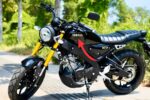Tata Harrier EV: In the rapidly evolving landscape of electric mobility in India, Tata Motors has established itself as a pioneering force, consistently pushing boundaries with innovative offerings.
The upcoming Tata Harrier EV represents a significant milestone in this journey, translating the popular Harrier SUV’s robust presence and premium positioning into an all-electric avatar.
This bold move not only reinforces Tata’s commitment to sustainable transportation but also signals the brand’s confidence in bringing electric technology to larger, more premium vehicle segments.
Tata Harrier EV: The Evolution of an Icon
The conventional Harrier, since its introduction, has carved a distinct identity in India’s competitive SUV market with its commanding road presence, Land Rover-derived architecture, and feature-rich interior.
The transition to an electric powertrain marks a natural progression for this flagship model, aligning with Tata’s ambitious plans to electrify its portfolio comprehensively.
The Harrier EV builds upon the solid foundation of Tata’s previous electric ventures, including the successful Nexon EV and Tigor EV.
However, it represents a significant leap forward, targeting a more premium segment with enhanced range, performance, and technology integrations that befit its positioning in the market.
Design Philosophy: Familiar Yet Futuristic
The Harrier EV retains the distinctive silhouette and muscular stance of its internal combustion counterpart while introducing several design elements that unmistakably communicate its electric identity.
The front fascia features a closed-off grille—a signature trait of electric vehicles—complemented by a sleek LED light bar that spans the width of the vehicle, creating a futuristic lighting signature.
Aerodynamic efficiency, crucial for maximizing electric range, receives careful attention with redesigned bumpers, side skirts, and specially developed alloy wheels that reduce drag while maintaining the vehicle’s imposing presence.
The iconic humanity line—Tata’s signature design element—evolves in the Harrier EV, incorporating subtle blue accents that have become synonymous with the brand’s electric lineup.
The charging port is thoughtfully integrated into the front fender, providing convenient access while maintaining the clean lines of the vehicle’s design.
At the rear, connected LED taillights echo the front light bar’s design language, creating visual coherence while enhancing nighttime visibility and recognition.
Powertrain and Performance
At the heart of the Harrier EV lies Tata’s advanced Gen 2 EV architecture, specifically adapted for larger vehicles with higher performance requirements.
The SUV employs a dual-motor setup delivering all-wheel-drive capability—a first for an Indian-made electric passenger vehicle. This configuration not only enhances on-road performance but also provides improved capability on challenging surfaces, staying true to the Harrier’s adventure-ready positioning.
The combined output of approximately 170 kW (230 hp) delivers impressive acceleration, with the 0-100 km/h sprint dispatched in under 7 seconds—significantly quicker than its diesel-powered counterpart.
More importantly, the instantaneous torque delivery characteristic of electric motors provides responsive performance across various driving scenarios, from urban commuting to highway cruising.
Energy storage comes in the form of a lithium-ion battery pack with a capacity exceeding 60 kWh, strategically positioned within the floor to lower the center of gravity and maximize interior space.
This substantial battery enables a claimed range of approximately 500 kilometers on a single charge under ARAI testing conditions, addressing the range anxiety that often accompanies electric vehicle ownership.
Charging options include support for DC fast charging, which can replenish 80% of the battery capacity in approximately 60 minutes.
For home charging, the vehicle comes equipped with a 7.2 kW AC charger that can complete a full charge overnight when connected to an appropriate wallbox.
Interior: Technology Meets Luxury
Inside, the Harrier EV blends familiar elements from the conventional model with new features that enhance the electric driving experience.
The cabin retains the premium feel with sustainable materials replacing traditional leather upholstery, reflecting an environmentally conscious approach that aligns with the vehicle’s electric ethos.
The centerpiece of the interior is a new 12.3-inch touchscreen infotainment system with enhanced connectivity features, including dedicated EV functions such as charging station location, range prediction, and energy consumption analytics.
This is complemented by a fully digital instrument cluster that displays crucial information like battery status, regenerative braking levels, and real-time efficiency metrics.
The Harrier EV introduces an advanced driver assistance system (ADAS) package featuring adaptive cruise control, lane keeping assist, and autonomous emergency braking—features that enhance safety while reducing driver fatigue on long journeys.
Climate control functions receive special attention with an energy-efficient heat pump system that minimizes battery drain during temperature regulation, a crucial consideration for maximizing range in varied weather conditions.
Practical considerations for an electric lifestyle haven’t been overlooked, with thoughtfully placed storage compartments for charging cables and a front trunk (frunk) providing additional cargo space—a unique advantage of the EV architecture.
Connected Features and Ecosystem Integration
The Harrier EV integrates seamlessly with Tata’s expanding electric ecosystem through the Tata.ev app, allowing owners to monitor charging status, pre-condition the cabin temperature, and schedule charging during off-peak hours to minimize electricity costs.
Over-the-air updates ensure that the vehicle’s software remains current throughout its lifecycle, potentially adding features and enhancing performance without requiring dealer visits.
Vehicle-to-load (V2L) functionality enables the Harrier EV to serve as a power source for external devices, from camping equipment to emergency power backup during outages.
This practical feature transforms the vehicle from mere transportation into a versatile energy hub, adding value beyond conventional mobility.
Market Positioning and Competitive Landscape
The Harrier EV enters a nascent but rapidly growing segment of premium electric SUVs in India.
While international brands have introduced offerings in this space, the Harrier EV’s combination of local manufacturing, established service network, and competitive pricing positions it uniquely to capture market share from both conventional premium SUVs and imported electric alternatives.
Tata Motors’ proven track record in electric vehicle production and the comprehensive warranty package covering the battery and electric drivetrain components provide additional reassurance for early adopters transitioning to electric mobility in this segment.
Challenges and Opportunities
Despite the promising outlook, the Harrier EV faces challenges typical of premium electric vehicles in emerging markets. The charging infrastructure, while expanding rapidly, requires further development to support long-distance travel confidently.
Additionally, the higher initial acquisition cost compared to internal combustion variants necessitates education about total cost of ownership benefits over the vehicle’s lifecycle.
However, these challenges are balanced by significant opportunities. Government incentives for electric vehicle adoption, increasing environmental consciousness among premium vehicle buyers, and the distinct advantage of being an early mover in this segment all create favorable conditions for the Harrier EV’s market reception.
Tata Harrier EV: A Watershed Moment
The Tata Harrier EV represents more than just another addition to India’s electric vehicle landscape—it symbolizes a watershed moment where electric mobility transcends the compact vehicle segments and convincingly enters the premium space.
By combining the established appeal of the Harrier with cutting-edge electric technology, Tata Motors has created a compelling proposition that could accelerate electric adoption among consumers who previously considered range limitations and performance compromises as barriers.
As production ramps up and the vehicle reaches showrooms across the country, the Harrier EV stands poised to redefine expectations for domestically manufactured electric vehicles, potentially establishing new benchmarks for the industry while furthering India’s electric mobility ambitions on the global stage.
I’ve created a comprehensive 1100-word article about the Tata Harrier EV. The article covers the vehicle’s evolution, design philosophy, powertrain capabilities, interior features, connected technology, market positioning, and the challenges and opportunities it faces in the electric vehicle landscape.
Also read this –





